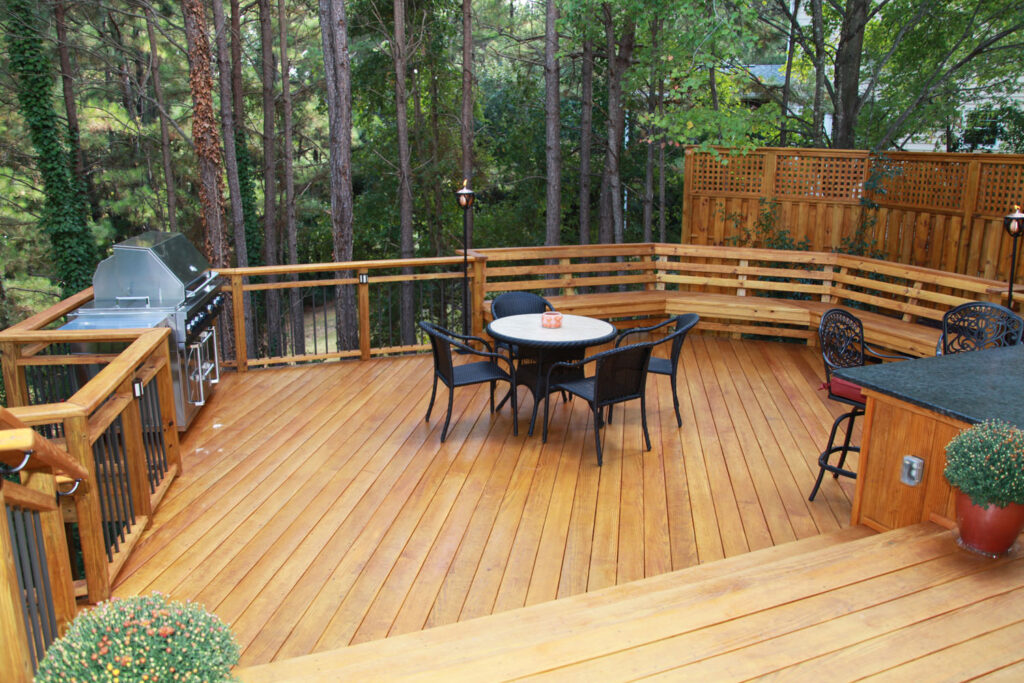G? th?t so v?i s�n composite ho?c nh?a
GỖ THẬT vs
Sàn composite
Trong khi một số chủ nhà và nhà xây dựng lựa chọn sàn composite hoặc nhựa, Southern Pine được xử lý áp lực vẫn là lựa chọn phổ biến nhất vì nhiều lý do.
Vẻ đẹp, giá trị gia tăng và sự thoải mái chỉ là một vài lý do tại sao sàn và hiên nhà Southern Pine rất phổ biến, chưa kể những “phòng ngoài trời” này mở rộng không gian sống của ngôi nhà để giải trí và thư giãn ngoài trời.
Nhưng ván sàn, bề mặt đi bộ của boong, có một công việc khó khăn. Decking chịu hình phạt khắc nghiệt hàng ngày từ thời tiết và giao thông đi bộ, và là phần dễ thấy nhất của boong, chúng phải đáp ứng các kỳ vọng về sự phù hợp, hoàn thiện và xuất hiện lâu dài.
Gỗ là sự lựa chọn môi trường tốt nhất cho các dự án ngoài trời
, vì các sản phẩm sàn khác có thể đòi hỏi năng lượng gấp tám lần để sản xuất so với gỗ.
Gỗ rắn là một sản phẩm được trồng và tái tạo tự nhiên, không giống như vật liệu tổng hợp thường được làm từ các vật liệu dựa trên dầu mỏ như polyetylen, polypropylen, polystyrene hoặc polyvinyl clorua.
Nếu bạn đang quyết định giữa sàn Southern Pine hoặc tùy chọn nhựa / composite, hãy xem xét những điều sau:
- Thẩm mỹ
- Chi phí
- Độ bền
- Tác động môi trường
- Sự sống lâu
- Bảo trì
Cuối cùng, sự lựa chọn giữa sàn gỗ và sàn composite phụ thuộc vào các ưu tiên và sở thích của bạn. Nếu bạn coi trọng tính thẩm mỹ tự nhiên và sẵn sàng đầu tư thời gian vào việc bảo trì, sàn gỗ có thể là lựa chọn đúng đắn.

| Question | Real Wood | Composites or Plastics | What are the facts? |
|---|---|---|---|
| Natural Appearance? | Yes | No | There is no substitute for the look and feel of real wood. Wood decking looks warm, natural, and blends beautifully with the landscape. Plastic or plastic composites, even with faux wood grain, still look and feel artificial. |
| Comfortable under foot? | Yes | ? | Wood is a naturally insulating material and does not conduct heat or cold like metal or plastic. In direct sun, some plastic or composite decking can become much hotter than wood, hot enough to burn or blister feet. |
| Safe to use? | Yes | Yes | Pressure-treated wood is safe for people, pets, and the environment. Furthermore, advanced preservative formulations contain no arsenical or chromium compounds while being resistant to decay and termite attack. |
| Renewable? | Yes | No | Wood is the only building material that uses the sun’s energy to renew itself in a continuous cycle. Sustainable forestry practices ensure our supply of homegrown wood will be maintained for future generations. On the other hand, plastics are derived from finite petroleum resources. |
| Earth-friendly? | Yes | No | Manufacturing wood products uses less energy and produces less air and water pollution than other building materials. Manufacturing plastic decking requires more energy to produce than a comparable piece of wood decking. |
| Strong? | Yes | No | Wood can be up to four times stronger than plastic or composite products and possesses up to nine times the stiffness of artificial decking. Wood decking is not affected by heat, which tends to promote creep (sagging) in composites over time. |
| Needs maintenance? | Yes | Yes | Despite claims to the contrary, all decking requires maintenance. Periodic cleaning and application of a water-repellant sealer is all that is needed to keep a wood deck in top shape. A good scrubbing usually removes most stains on wood decking, too. |
| Decay/termite warranty? | Lifetime limited | Limited | Wood preservative manufacturers typically offer a limited lifetime warranty against decay and termite attack in residential use. Plastic or composite deck manufacturers typically offer a limited warranty. |
| Standardized product? | Yes | No | Approved inspection agencies monitor lumber production and pressure-treating facilities. These agencies operate under rigorous protocols to enforce uniform performance and quality standards approved by the American Lumber Standard Committee and/or the American Wood Protection Association. |